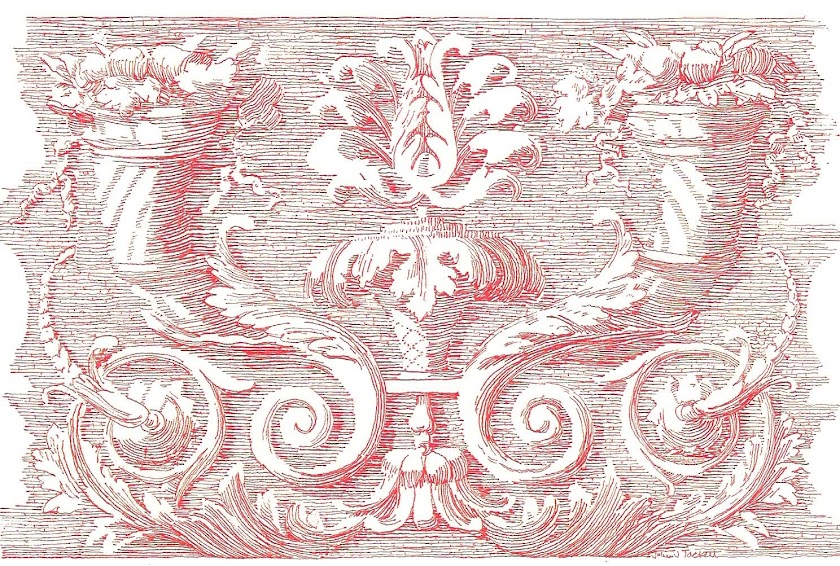In full disclosure, James Abbott is a valued friend of almost twenty years, since we were classmates in the Attingham Summer School in England. In addition to authoring several exceptional books, he has been the curator/director of a number of great house museums, and he is a talented artist as well as all-around Good Guy. I was an excited youngster when First Lady Jacqueline Kennedy gave a televised tour of the sophisticated improvements to the White House, many with the input of Stephane Boudin of Jansen, we were later to learn. I became familiar with Maison Jansen as a teen, seeing their work credited in library books featuring European architecture and interior design. I really became a fan, however, after seeing their designs published in 1971 for the four day celebration of the 2,500th Anniversary of the Empire at the ruins of Persepolis, Iran, as shown in the model above. Jansen designs have often be inspirations for my own projects and my fascination with the Kennedy White House decoration has been enriched with conversations with James over the years with my knowledge of Sister Parish's valuable contributions. I was not disappointed when JANSEN was published.
I am writing about Maison Jansen because there are still many design professionals and enthusiasts that are unfamiliar with the noted inteior design firm. In James A. Abbott's JANSEN, he states that Maison Jansen was the most famous and influential interior decorating company of the 20th century. I resisted accepting that claim at first, but I fully embraced it after reading the book. The Jansen client list was a very diverse international group; most of them powerful and all were rich. With headquarters in Paris, there were eventually offices or boutiques in Buenos Aires, London, Cairo, Alexandria, Havana, New York, Prague, Sao Paulo, Rome, Milan, and Geneva.
Jayne (Mrs. Charles B.) Wrightsman, is shown above, in 1959, in the Library of her house in Palm Beach, Florida, as refurbished by Stephane Boudin of Maison Jansen. The original 1917 house known as Blythedunes was designed by H. Hastings Mundy for Robert Dun Douglas whose family founded Dun & Bradstreet. In 1930, it was sold to Harrison Williams, a utilities magnate who was once considered one of the world's richest men, and his wife Mona, a renown beauty, who hired architect Maurice Fatio and decorator Syrie Maugham to restyle the house into one of the most stylish of its time. Financial reverses led to the sale to multimillionaire oilman Charles Wrightsman and his second wife Jayne who had become a serious student of decorative arts, especially those associated with 18th century France. To make the house her own and satify her own interests, Mrs Wrightsman hired Jansen who paneled three rooms in period 18th century woodwork, altered and augmented as necessary in their own workshops, and floored four rooms in parquet of royal provenance. The dazzling 18th century handpainted Chinese wallpaper installed by Syrie Maugham remained in the Drawing Room, but a Louis XV marble chimneypiece, set against a floor-to-ceiling framed mirror, replaced a larger baronial English fireplace. Museum quality antique furniture was supplemented by handmade new furniture, also from the Jansen workshops, and the decor complimented the Wrightsmans' collection of Impressionist paintings. After Boudin's death in 1967, other designers were called upon for maintenance and updating, notably Vincent Fourcade. When the house was sold in 1984 to Leslie Wexner of The Limited and Victoria's Secret, some of the antiques and art were divided between the Metropolitan Museum of Art and the Wrightsmans' Manhattan apartment. So-called lesser pieces were sold at a celebrated auction by Sotheby's New York, an eye-opening event I experienced first hand with "decorative" and "second hand" furnishings selling for record prices. Wexner demolished the famed house on six acress at 513 North County Road with 600 ft of ocean frontage, causing such an uproar from locals, that he abandoned plans to build a new house (designed by my former employer BeyerBlinderBelle) and decided against having a vacation house in Palm Beach after all. Jayne Wrightsman, b. 1920, who introduced Boudin to Jackie Kennedy, still lives in a palatial, full-floor, art and antiques-filled apartment at 820 Fifth Avenue, one of New York City's most desirable addresses.
And the Wrightsmans are just one of the many clients and projects profiled in the book! There is also a sequel of sorts, Jansen Furniture, to be reviewed in a future post. Both are highly recommended for anyone interested in interior design.
Both Jansen books by James Archer Abbott are available at discount pricing with the option of free shipping through The Devoted Classicist Library in affiliation with Amazon here.




